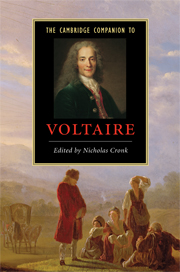Book contents
- Frontmatter
- Introduction
- 1 The making of a name: a life of Voltaire
- 2 Voltaire and authorship
- 3 Voltaire: philosopher or philosophe?
- 4 Voltaire and clandestine manuscripts
- 5 Voltaire and the myth of England
- 6 Voltaire’s masks: theatre and theatricality
- 7 Voltaire as story-teller
- 8 Candide
- 9 Voltaire and history
- 10 Voltaire’s correspondence
- 11 Voltaire: pamphlets and polemic
- 12 Voltaire and the politics of toleration
- 13 Voltaire and the Bible
- 14 The Voltaire effect
- Further reading
- Index
8 - Candide
Published online by Cambridge University Press: 28 May 2009
- Frontmatter
- Introduction
- 1 The making of a name: a life of Voltaire
- 2 Voltaire and authorship
- 3 Voltaire: philosopher or philosophe?
- 4 Voltaire and clandestine manuscripts
- 5 Voltaire and the myth of England
- 6 Voltaire’s masks: theatre and theatricality
- 7 Voltaire as story-teller
- 8 Candide
- 9 Voltaire and history
- 10 Voltaire’s correspondence
- 11 Voltaire: pamphlets and polemic
- 12 Voltaire and the politics of toleration
- 13 Voltaire and the Bible
- 14 The Voltaire effect
- Further reading
- Index
Summary
Candide, ou l'Optimisme was an instant best-seller: within the year of its publication early in 1759 there were dozens of pirated editions, and its popularity has never lagged in the two and a half intervening centuries. As Candide is for many readers their first introduction to the Enlightenment, one is entitled to ask, among other things, what kind of image of the Enlightenment it projects, and how representative it can be thought to be. As is characteristic of Voltaire's method during his Geneva and Ferney years, he published Candide anonymously, pretending to know nothing about it. His friends and even, no doubt, many public officials knew this was a feint. The addendum 'Translated from the German of Dr Ralph' is a typical cover, reinforcing the fictional pretence that the work was of foreign origin.
Ideas
Along with the announced theme of 'Optimism', Voltaire picks up on several other key terms commonly linked with the philosophy of Gottfried Wilhelm Leibniz (1646-1716), notably raison suffisante and harmonie préétablie. These both appear, for example, in D'Alembert's Discours pré- liminaire to the Encyclopédie in 1751, and relate to Leibniz's resolution of the problem of theodicy, the existence of evil in a divinely created universe (his Essais de théodicée had appeared in 1710). It was not in God's power, he reasoned, to create a perfect world, but among possible worlds, he created the best - a notion which Voltaire mocks with the expression 'the best of all possible worlds' ('le meilleur des mondes possibles') - or, for that matter, of all possible chateaux, or of all possible barons' daughters. In Zadig, ten years earlier, Voltaire had himself sketched such a tentative Leibnizian conclusion.
- Type
- Chapter
- Information
- The Cambridge Companion to Voltaire , pp. 125 - 138Publisher: Cambridge University PressPrint publication year: 2009
- 4
- Cited by

